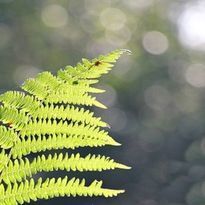Mosa Mack’s Photosynthesis unit focuses on the process itself and the importance of sunlight. Students will be led through a series of 3 lessons, including an inquiry-based photosynthesis mystery, a photosynthesis experiment, and a design challenge, all using project-based approaches.
- Lesson 1
Solve: Ailing Fern Mystery + Vocabulary Mind Map
Students create a vocabulary manipulative before diving into Mosa Mack’s mystery of the ailing fern. Following the mystery, students take an interactive quiz and explain the solution. (60 - 90 min)
- Lesson 2
Make: Gather Evidence to Prove Photosynthesis is Occurring
Students design and carry out an experiment to observe evidence of photosynthesis. (120 - 180 min)
- Lesson 3
Engineer: Use Photosynthesis to Engineer a Solution for Fish in Danger
Using what was learned in the Solve and Make, students design and carry out a solution to help a local pet store with their fish tank problem. (120 mins)
- Next Generation Science Standards
- MS-LS1-6
- Construct a scientific explanation based on evidence for the role of photosynthesis in the cycling of matter and flow of energy into and out of organisms. [Clarification Statement: Emphasis is on tracing movement of matter and flow of energy.] [Assessment Boundary: Assessment does not include the biochemical mechanisms of photosynthesis.]
- MS-LS1-7
- Develop a model to describe how food is rearranged through chemical reactions forming new molecules that support growth and/or release energy as this matter moves through an organism. [Clarification Statement: Emphasis is on describing that molecules are broken apart and put back together and that in this process, energy is released.] [Assessment Boundary: Assessment does not include details of the chemical reactions for photosynthesis or respiration.]
- Inquiry Scale
- Each lesson in the unit has an Inquiry Scale that provides directions on how to implement the lesson at the level that works best for you and your students.
- “Level 1” is the most teacher-driven, and recommended for students in 4th-5th grades. “Level 4” is the most student-driven, and recommended for students in 7th-8th grades.
- For differentiation within the same grade or class, use different inquiry levels for different groups of students who may require additional support or an extra challenge.
- Common Misconceptions
- Learners often confuse photosynthesis and cellular respiration, thinking that photosynthesis makes useable energy, when in fact it makes glucose from the sun’s energy.
- A common misconception by students is that the bubbles created by underwater plants such as Elodea are just like the bubbles we create when we breathe out underwater. However, emphasize to students that the byproduct of photosynthesis is oxygen, not carbon dioxide. When we breathe out bubbles underwater, it is carbon dioxide, which is the byproduct of a different process, known as cellular respiration. This also applies to the Spinach Leaf Disk Lab.
- Vocabulary
- Photosynthesis
- Chloroplast
- Carbon Dioxide
- Oxygen
- Glucose
- Sunlight
- Water
- Content Expert
- Clive G. Jones
Terrestrial Ecologist, Cary Institute of Ecosystem Studies
Expertise: Biodiversity, Environmental Management
- Leveled Reading
* To give our users the most comprehensive science resource, Mosa Mack is piloting a partnership with RocketLit, a provider of leveled science articles.
- Using the Sun's EnergyThis article gives the students an overview of how plants use energy from sunlight to create chemical energy that they use to live. This is very different from how animals get their energy by eating other living things. Plants use photosynthesis to make their food and this is done in small parts inside of the plant cells called chloroplasts.
RocketLit serves NGSS aligned reading at 7 reading levels.
- Live, Laugh, LoveThis article focuses on the different types of organisms on our planet: ones that need oxygen and ones that don't. Scientists believe the first life on the planet were anaerobic and that over time gained the ability to use photosynthesis to create usable energy. The atmosphere may have been inhabitable for people at the beginning of our planet and these organisms slowly changed it over time to enable aerobic organisms to flourish.
RocketLit serves NGSS aligned reading at 7 reading levels.
- Molecules for Life: You Need SugarIn this article, students read about where sugars in the ecosystem come from photosynthesis and how living things use stored energy in sugars like to get the energy they need to live.
RocketLit serves NGSS aligned reading at 7 reading levels.
- Light Energy to Life EnergyAt the base of every food chain are autotrophs. These living things make their own energy from sunlight through photosynthesis and they (and organisms that eat them) can then use that energy they made through cellular respiration. Energy is continuously transferred to different organisms as they eat each other. Yum!
RocketLit serves NGSS aligned reading at 7 reading levels.
- Inside the ChloroplastYou may need to walk to the store or refrigerator for food later on today, but not that plant outside your window. Their chloroplasts are hard at work absorbing the sun's energy to create carbohydrates. In addition, you and the plant are the colors you are due to pigments that absorb some colors of light and reflect others. You skin doesn't do much with that absorbed light, but the plant uses it to make food!
RocketLit serves NGSS aligned reading at 7 reading levels.
- What Goes Into Photosynthesis?Plants can't get up and walk to the store for a bite to eat. Instead, they use energy from sunlight to create sugars that they can use for the energy they need to live, just like our bodies use the food we eat to keep us alive.
RocketLit serves NGSS aligned reading at 7 reading levels.









